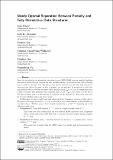| dc.contributor.author | Demaine, Erik | |
| dc.contributor.author | Williams, Virginia Vassilevska | |
| dc.contributor.author | Chen, Lijie | |
| dc.contributor.author | Gu, Yuzhou | |
| dc.contributor.author | Xu, Yinzhan | |
| dc.contributor.author | Yu, Yuancheng | |
| dc.date.accessioned | 2021-11-08T17:30:17Z | |
| dc.date.available | 2021-11-08T17:30:17Z | |
| dc.date.issued | 2018 | |
| dc.identifier.uri | https://hdl.handle.net/1721.1/137723 | |
| dc.description.abstract | © Lijie Chen, Erik D. Demaine, Yuzhou Gu, Virginia Vassilevska Williams, Yinzhan Xu, and Yuancheng Yu. Since the introduction of retroactive data structures at SODA 2004, a major unsolved problem has been to bound the gap between the best partially retroactive data structure (where changes can be made to the past, but only the present can be queried) and the best fully retroactive data structure (where the past can also be queried) for any problem. It was proved in 2004 that any partially retroactive data structure with operation time T op (n, m) can be transformed into a fully retroactive data structure with operation time O(m · T op (n, m)), where n is the size of the data structure and m is the number of operations in the timeline [7]. But it has been open for 14 years whether such a gap is necessary. In this paper, we prove nearly matching upper and lower bounds on this gap for all n and m. We improve the upper bound for n m by showing a new transformation with multiplicative overhead n log m. We then prove a lower bound of min(n log m, m) 1− o (1) assuming any of the following conjectures: Conjecture I: Circuit SAT requires 2 n −o(n ) time on n-input circuits of size 2 o (n ) . This conjecture is far weaker than the well-believed SETH conjecture from complexity theory, which asserts that CNF SAT with n variables and O(n) clauses already requires 2 n −o(n ) time. Conjecture II: Online (min, +) product between an integer n × n matrix and n vectors requires n 3 −o (1) time. This conjecture is weaker than the APSP conjectures widely used in fine-grained complexity. Conjecture III (3-SUM Conjecture): Given three sets A, B, C of integers, each of size n, deciding whether there exist a ∈ A, b ∈ B, c ∈ C such that a + b + c = 0 requires n 2− o(1) time. This 1995 conjecture [13] was the first conjecture in fine-grained complexity. Our lower bound construction illustrates an interesting power of fully retroactive queries: they can be used to quickly solve batched pair evaluation. We believe this technique can prove useful for other data structure lower bounds, especially dynamic ones. | en_US |
| dc.language.iso | en | |
| dc.relation.isversionof | 10.4230/LIPIcs.SWAT.2018.33 | en_US |
| dc.rights | Creative Commons Attribution 4.0 International license | en_US |
| dc.rights.uri | https://creativecommons.org/licenses/by/4.0/ | en_US |
| dc.source | DROPS | en_US |
| dc.title | Nearly optimal separation between partially and fully retroactive data structures | en_US |
| dc.type | Article | en_US |
| dc.identifier.citation | Demaine, Erik, Williams, Virginia Vassilevska, Chen, Lijie, Gu, Yuzhou, Xu, Yinzhan et al. 2018. "Nearly optimal separation between partially and fully retroactive data structures." | |
| dc.contributor.department | Massachusetts Institute of Technology. Computer Science and Artificial Intelligence Laboratory | |
| dc.contributor.department | Massachusetts Institute of Technology. Department of Electrical Engineering and Computer Science | |
| dc.eprint.version | Final published version | en_US |
| dc.type.uri | http://purl.org/eprint/type/ConferencePaper | en_US |
| eprint.status | http://purl.org/eprint/status/NonPeerReviewed | en_US |
| dc.date.updated | 2019-06-05T13:11:26Z | |
| dspace.date.submission | 2019-06-05T13:11:27Z | |
| mit.license | PUBLISHER_CC | |
| mit.metadata.status | Authority Work and Publication Information Needed | en_US |
